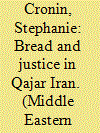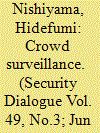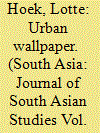| Srl | Item |
| 1 |
ID:
162520


|
|
|
|
|
| Summary/Abstract |
In 1971, E. P. Thompson published a seminal article on eighteenth century English bread riots which was to become a foundational text for the study of such protests. Challenging older elite notions of the irrationality, illegitimacy and even criminality of the ‘mob’, Thompson situated popular direct action in times of food crises within a very specific historical, economic and, most importantly, cultural context. This context produced a deeply held adhesion among the poor to the concept of a ‘moral economy’ and an equally profound rejection of the free market as enshrined in the new political economy of the eighteenth century. This article returns to Thompson's original text in order to assess to what extent his paradigm may be useful in understanding bread riots in Iran. In particular, it examines the evidence which supports the notion that Iran experienced a ‘golden age’ of bread riots in the 1890s and early 1900s, just before and indeed contributing to the outbreak of the constitutional revolution.
|
|
|
|
|
|
|
|
|
|
|
|
|
|
|
|
| 2 |
ID:
159786


|
|
|
|
|
| Summary/Abstract |
The recent proliferation of the securitization of crowded places has led to a growth in the development of technologies of crowd behaviour analysis. However, despite the emerging prominence of crowd surveillance in emergency planning, its impacts on our understanding of security and surveillance have received little discussion. Using the case of crowd surveillance in Tokyo, this article examines the ways in which crowds are simulated, monitored and secured through the technology of crowd behaviour analysis, and discusses the implications on the politics of security. It argues that crowd surveillance constitutes a unique form of the biopolitics of security that targets not the individual body or the social body of population, but the urban body of crowd. The power of normalization in crowd surveillance operates in a preemptive manner through the codification of crowd behaviour that is spatially and temporarily specific. The article also interrogates the introduction of crowd surveillance in relation to racialized logics of suspicion and argues that, despite its appearance as non-discriminatory and ‘a-racial’, crowd surveillance entails the racial coding of crowd behaviour and urban space. The article concludes with the introduction of crowd surveillance as a border control technology, which reorients existing modalities of (in)securitization at airports.
|
|
|
|
|
|
|
|
|
|
|
|
|
|
|
|
| 3 |
ID:
144360


|
|
|
|
|
| Summary/Abstract |
What do film posters on city walls tell us about the relationship between the cinema and the city? In this paper, I rely on the practice and perspective of young men who put up film posters on Dhaka's city walls to explore this question. I argue that the wall is a key site for the production of a cinematic public that does not map onto film audiences; for the experience of newness in the city and of the cinema as analogous experiences; and for an encounter with imagery that is considered luminous and intense, assailing the crowds that pass by the posters in the congested city.
|
|
|
|
|
|
|
|
|
|
|
|
|
|
|
|